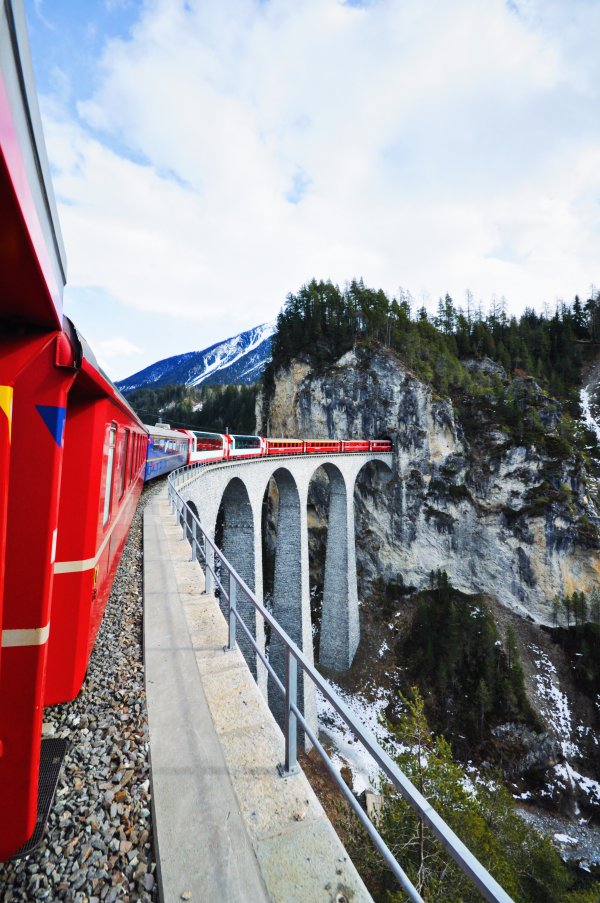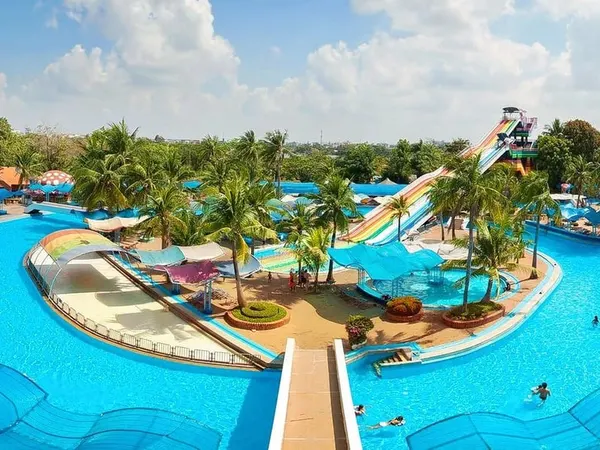
Gap Year Adventures: 6 Must-See Spots in Europe By Rail

Backpacking around Europe has been a right of passage for many young people since the 1970s. But a lot has changed since the heyday of the rail pass! High-speed trains now criss-cross the continent, night trains are few and far between, and yield-managed fares make rail passes less cost-effective.
Travellers have changed too – thanks to data roaming and mobile technology they’re more tech savvy and better-connected. It’s against this backdrop that tools like Loco2 emerged to make it easier for travellers to make the most of Europe by train, skipping the luggage fees, airport queues and environmental impact of short-haul flights for a more enjoyable journey on the rails.
My first taste of European rail was the same as many of my peers – a 3-month adventure with friends, taking in the sights, sounds and parties of Europe. But for me, that trip around Europe was just the start of a much bigger journey.
It all started when I realised that my passion for protecting the environment was incompatible with the culture of frequent flying that’s normally associated with gap year travel. Inspired to do things differently, while at university, I signed a Flight Pledge that committed me to 12-months flight-free.
That was the beginning of a long journey that continues to this day. I cut my teeth in Europe, exploring Spain, Italy, Croatia, Slovenia, Slovakia, Hungary, Poland and Germany by train. But I soon realised that I’d need to go further afield to really fulfil my travelling ambition.
That’s how at the end of 2007 I found myself aboard a cargo ship from Dover to Costa Rica in what was to become the start of a flight-free adventure around the world.
Over the next two years, I circumnavigated the globe by land and sea, travelling by cargo ship across the Atlantic, a 47-foot yacht across the Pacific Ocean, and overland from Singapore to the UK via China, Mongolia and Russia by train, bus, motorbike and the occasional yak!
But every journey has to start somewhere! And Europe has so much to offer for young travellers – a fact so often overlooked by those who hop on a flight to Thailand without a second thought – we’ve selected the first stop for a number of recommended itineraries by train for backpackers in Europe.
1. Girona, Spain

The penultimate stop on the Paris to Barcelona TGV, Girona is only an hour away from Barcelona and often overlooked in favour of its noisy neighbour. But Girona is a city worth visiting in its own right and a good first stop in Spain. Arguably better looking, cheaper, and certainly more laid back than Barcelona, this ancient city has many of the charms of the Catalan capital without the trappings of fame.
Stroll along the banks of the Onyar River, enjoying the colourful modernist building that flank its banks. Or hop up onto the restored city walls – called Passeig de la Muralla – that snake around the city, with fantastic views of the city below. If architecture’s your thing, the museum dedicated to Rafael Masó – Casa Masó – is worth a visit. Or if you want to get out and explore, get out into the Catalan countryside with a bike tour.
Getting there: The journey from London to Girona by train takes just over 10 hours by Eurostar and high-speed, double-decker TGV. The train speeds through Burgundy vineyards and the Rhône Valley, then west along the Mediterranean coast towards the Pyrenees before diving under the mountains in the Perthus Tunnel.
Next stop: The obvious next stop is Barcelona, and it’s definitely worth a visit in spite of the hype. But once you’ve had your fill, use Barcelona as a springboard to other parts of Spain – direct trains connect Valencia, Madrid and Bilbao to name a few. And with one change of train, the rest of Spain is within reach too by high-speed AVE – head to Mundaka (near Bilbao) for surf school, Granada for the Alhambra, or even catch a ferry to Morocco from Gibraltar.
2. Prague, Czech Republic

Next up on my list is Prague – a beautiful city that has a lot to offer. Yes, it has become very touristy, and can at time feel overrun by stag dos, but it hasn’t lost any of its charm. If you can, visit in spring or early autumn when the weather is mild and there are fewer crowds.
Fill your days with visits to Prague Castle, the attractive Old Town Square and Prague-Jewish museum, each of which gives a glimpse of the city’s fascinating past from medieval to modern. It’s a great option for travellers who want to walk through cobbled streets and be inspired by the art and architecture, literature and history of central Europe.
When the sun sets, Prague comes alive with a nightlife that lives up to expectations – from traditional Beer Halls, to the modern 32-tap Beer Geek bar – if there’s one thing Czechs do best, it’s beer. But there’s much more besides on offer from this cosmopolitan city, from the elegant 100-year-old Café Louvre, to jazz clubs and the spectacular Divoká Šárka urban woodland.
Getting there: There are lots of ways to get to the Czech capital from the UK, most of which start with a Eurostar to Brussels. From there, you can travel to Prague the next day via a number of routes: head to Zurich to join a EuroCity night train, or go via Berlin (with or without a stop) before completing your journey to the Czech Republic.
Next stop: Prague occupies a fantastic location in the heart of Central Europe, making it possible to quickly hop to neighbouring countries. Three other European capital cities are all just four or five hours away by train: Berlin, Bratislava and Vienna. Prague also has direct train services to Budapest (7hrs) and Munich (6hrs). There are also direct night trains to Krakow, Minsk, Moscow, Warsaw and Zurich.
3. Rome, Italy

This relentlessly energetic city boasts ancient ruins, showpiece baroque architecture and some of the world’s most dazzling collections of art. Rome is a must-see for anyone interested in art or history and is a popular choice for students of Italian.
There are many classic sites you’ll want to tick off – the Colosseum, The Vatican, the Pantheon, and Trevi Fountain – but, like Paris or Venice, it’s packed with tourists. Rome is one of the world’s most visited cities and so finding somewhere off the beaten path can be hard, but they do exist.
Try Trastevere on the west bank of the Tiber for medieval alleyways, artisan workshops, and a thriving nightlife. Or stroll into Monti, an eclectic neighbourhood near the city centre, but still a charming cluster of cobbled streets and independent businesses. For a Shoreditch-vibe, try Pigneto which is fast becoming one of the city’s trendiest suburbs.
Getting there: Hop on a Eurostar to Paris to board the Thello sleeper train to Italy, alighting in Milan (the Paris-Rome service was discontinued some years ago). It’s one of few remaining night trains in Western Europe, but don’t expect the Orient Express – it’s far from luxury – but with tickets from £26 for a couchette, let’s just say that it’s appropriately priced.
Next stop: The rest of Italy of course! Direct trains connect Rome to Florence (for the art!), Venice (for the canals), or Verona (for a break from Venice) and much more. You can even get an overnight train from Rome (or Naples) to Sicily’s capital, Palermo, a train that is loaded onto a ferry for the short hop across Strait of Messina.
Once you’ve had enough of Italy, head north into Austria or even catch a ferry from Italy’s south to Croatia – the Bari to Dubrovnik overnight boat is a fun way to reach Croatia for onward itineraries that include Bosnia, Serbia, Albania and Greece.
4. Amsterdam, The Netherlands

Famed for its tree-lined canals, café culture, and gung-ho cyclists, Amsterdam has long attracted admirers from all over the world. This is a city that makes you feel instantly at home, as you quickly adapt to the locals’ way of life – whether it’s relaxing in a kerbside café, renting a bike, or devouring delicious pancakes – it’s a great first stop on your travels around Europe.
Nearby Utrecht, one of the Netherlands’ oldest cities, is also worth a visit. Cited by some as a mini Amsterdam, go for a day to explore the medieval old town and indulge in some canal-side dining. It’s just 25 minutes by direct train from Amsterdam, with cheap fares available on the day.
The Netherlands also plays host to several house, techno and electronic festivals. From the Awakenings Festival (touted as Europe’s biggest electronic music event) to Lowlands, and Mysteryland, there are lots of events vying to provide backpackers with an unforgettable party.
Getting there: Eurostar launched its much-anticipated direct train from London to Amsterdam in April 2018. There are two services every day, with a journey time of just 3 hours 40 minutes, so hop on the morning departure to arrive in Amsterdam in time for lunch.
Tickets for the direct train are available from six months in advance, starting from £35 one-way, making it a great way to save money at the start of your trip if Paris or Brussels aren’t part of your plan. The price can triple as the date of travel approaches, so this is a route where it pays to book well in advance.
Next stop: Amsterdam is a key hub in the Dutch national rail network with departures at least hourly to most major cities across the Netherlands. But it’s well-connected to its neighbours as well – direct trains head to Paris, Brussels, Berlin and Basel – making it a useful starting point for exploring this part of Europe.
Although there have been no direct international night trains from Amsterdam since late 2016, there is an evening fast train from Amsterdam to Düsseldorf which connects conveniently into direct overnight services to Munich, Innsbruck, Linz and Vienna.
5. Munich, Germany

Bavaria, a fairy tale land of enchanting villages, gorgeous scenery, and traditional festivals. It’s capital, Munich is also one of the tourist capitals of the world, visited by many backpackers exploring Germany. But backpackers beware, though less expensive than Paris or London, Munich isn’t the cheapest place to visit so it’s worth planning ahead to make the most of your budget. And give Octoberfest a wide berth – prices skyrocket for just about everything during the festival.
Having said that, Munich is a city with a lot going on, much of which can be done on a shoe string – from beer halls and beer gardens, buzzing squares and museums (many of which offer free or €1 admission on Sundays) to a perpetual wave for surfers on the edge of the English Garden park – there’s lot to do without splashing out! A good place to start is with a free walking tour (pay only what you can afford) – Sandeman’s New Europe Tours are the best introduction to a new city.
Getting there: Like all German cities, London-Munich can be booked for as little as £50 thanks to the Super Sparpreis fare. These cheap train tickets from London to almost every Germany city include Eurostar via Brussels and onward travel on ICE services within Germany, for a bargain price. They can be booked 6 months in advance, at one minute to midnight in Germany 180 days before travel – that’s 22:59 GMT if you’re really serious about getting the best price!
Next stop: Munich has excellent international connections to cities across Europe. Comfortable EuroCity trains run by ÖBB Austrian Railways run from Munich direct to Innsbruck, Verona, Bologna and Venice. While fast Railjet trains leave Munich for Vienna and Budapest. There’s also a great choice of overnight trains from Munich (although not all of these can be booked on Loco2) to Budapest, Düsseldorf, Florence, Hamburg, Milan, Rome, Venice or Zagreb.
6. Lyon, France

Lyon might seem like an odd choice as a first point of call for a backpacker, but the direct Eurostar makes it an easy way to travel by train into the heart of France, while giving (expensive) Paris a wide berth. And once you arrive, there’s more than meets the eye.
The city has enough attractions – not to mention fantastic gastronomic delights – to give Paris a run for its money. During the day, there’s plenty to do, from the traditional Museum of Fine Arts to the modern Mac gallery, the recently opened Musée de Confluence. And that’s just for starters.
At night, Lyon comes alive! Underneath its quaint exterior lies Lyon’s student hub and booming techno culture. Every May, the biggest event is Nuits Sonores, a five-day electronic music festival in a disused factory. But in spring and summer, few weekends go by without dozens of big-name DJs descending on the city to play dedicated electro clubs (like La Sucre), or boat bars (like Sirius) that float on the River Rhône.
Getting there: The city is served by a direct Eurostar from London to Lyon, making it an easy first leg on a longer trip. The direct train previously ran during summer months only but, due to its popularity, now runs year-round. The direct Eurostar bypasses Paris so you can travel from London to Lyon by train in 4 hrs 41 mins. Trains depart once a week on Saturdays in winter and three or four times a week in spring and summer.
Next stop: There is a daily train from Lyon to Turin (3 hrs, 53 mins) and Milan (5hrs 20 mins). It’s a short hop from Lyon into the French Alps, or into Switzerland with about eight trains each day from Lyon to Geneva. There are also fast once-daily direct links from Lyon to Basel, Baden Baden (for the Black Forest), Frankfurt, Girona and Barcelona.
By: Kate Andrews, Co-Founder and COO of award-winning Loco2 – the comparison and booking platform for train tickets in the UK and Europe














































